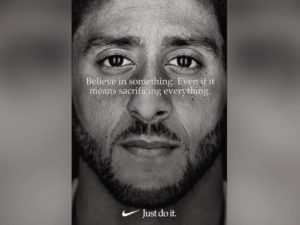I’ve been out of high school long enough for what was in “then” to be back in style now. Growing up my mom had incredible fashion sense and would pick things out for me, and out of both obedience and actually liking what she picked 99% of the time I would wear it. I’ve actually been coined a fashionista by some, so thanks mom – you set me up for life!
Momma and I didn’t always agree though, especially when it came to back-to-school sneakers. These sneakers were always so expensive, and sometimes I would end up with Nike’s, but it wouldn’t be the ones I really wanted. Walking through the mall this weekend I looked to my right and saw on window display the Nike Airmax 95’s. I was flabbergasted. I walked by as is if I didn’t see them and quickly turned around just to go back and stare at them. My momma was right – hold on to your clothes because fashion is cyclical. After all these years, they’re back. Sure, Jordan’s are retro and come and go in rotation, but seeing those Airmax 95’s under those display lights was different. And just like that, I went back to where I was years ago when I first wanted those shoes. I started daydreaming. After all this time I still want those shoes.
And after all these years Nike still manages to resonate with consumers. With a mission to “bring inspiration and innovation to every athlete in the world” and qualifying just who athletes are -“if you have a body you are an athlete”, the Nike message is transferable and relevant to many (Nike, 2018). Newborn babies may be the only ones who haven’t heard their 30 year old slogan “Just Do It”. Though met with public controversy, Nike in collaboration with global creative company Wieden+Kennedy released the “Dream Crazy” campaign featuring Colin Kaepernick, the former San Francisco 49ers quarterback who took a stand against racial injustice by kneeling during the national anthem at NFL football games (Schultz & Pasquarelli, 2018). The ad has an emotional appeal and features champion athletes like Lebron James and Serena Williams as well as athletes overcoming obstacles, being resilient, and willing to stand out to stand up for their dream. The creative direction, content and images are all consistent with inspiration and consistent for Nike.
However, all did not find the ad, a little over 2 minutes long, inspirational. To protest Nike’s bold move, some consumers boycotted by recording themselves burning, cutting or destroying their Nike gear and then posting it to social media or YouTube (Youn, 2018). But for those who were inspired, more than being consumers or supporters of Nike, racial justice, defying the odds or Colin Kaepernick, they could represent the growing number of consumers that opt-in to brands that have an open position regarding real issues in society or the culture (Smither, 2018). Versus a person becoming a mouth piece on an issue, more consumers are looking to brands to be that mouth piece to say what they as consumers can’t say or to reach a greater audience with a message they also agree on. For brands, this builds a connection with consumers that can lead to higher engagement (Smither, 2018), and in Nike’s case a serious spike in sales (Martinez, 2018). For marketers (and advertisers), this creates more opportunities to create content and tell stories that will appeal to their target audience to ultimately lead to people taking action, especially when the delivery of the creative concept is totally on brand (Youn, 2018). Action today includes but is not limited to making a purchase. It can also be subscribing to a brand’s email or newsletter, following them on social media, sharing their content or talking about them on social media.
We keep hearing it – everybody has a story. It’s true. We all do. And so many, even if unspoken have dreams too. The “Dream Crazy” campaign says, “It’s only a dream until you do it.” After watching the ad featuring Colin, more than before do I want to go back to that store and buy those Air Max’s. They’re still expensive, but I can take care of them long enough to see them come around again.
References:
Martinez, G. (2018). Despite outrage Nike sales increased 31% after Kaepernick ad. Time. Retrieved from http://time.com/5390884/nike-sales-go-up-kaepernick-ad/
Nike. (2018). About. Nike, Inc. Retrieved from https://about.nike.com/
Schultz, E.J. & Pasquarelli, A. (2018). Nike unveils lengthy Kaepernick spot. AdAge. Retrieved from https://adage.com/article/cmo-strategy/nike-unveils-lengthy-kaepernick-spot/314830/
Smither, K. (2018). Planning with a point of view: From Nike to Burger King. WARC. Retrieved from https://www.warc.com/content/paywall/article/warc-exclusive/planning_with_a_point_of_view_from_nike_to_burger_king/123895
Youn, S. (2018). Nike’s Colin Kaepernick ‘Just Do It’ campaign is controversial, but on brand: Experts. ABC. Retrieved from https://abcnews.go.com/Business/nikes-colin-kaepernick-campaign-controversial-brand-experts/story?id=57590454



8 Responses to Just Say It: How Brands Inspire Consumers